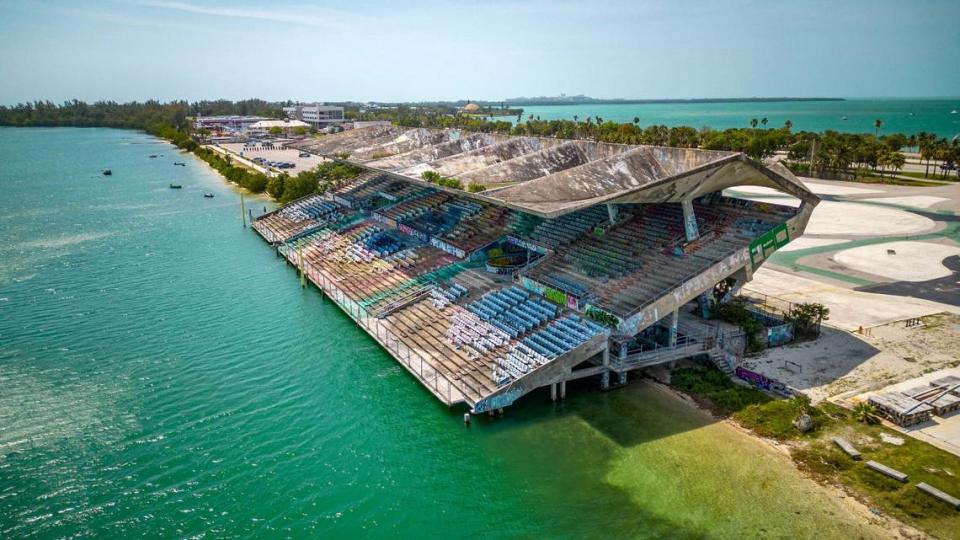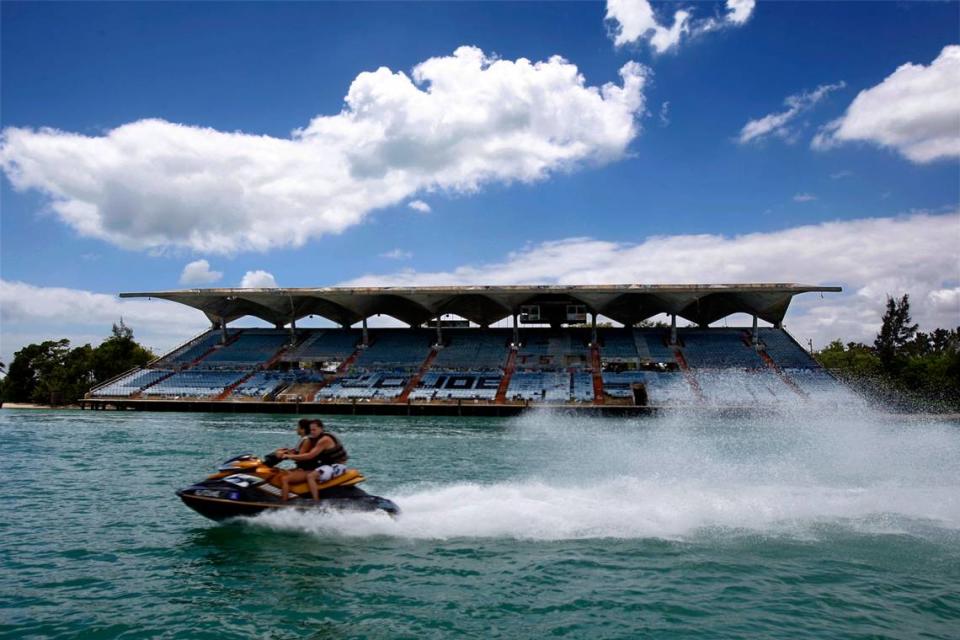This Miami landmark may finally be saved. Making the case for the Marine Stadium | Opinion
Miami Marine Stadium is an example of what is so wrong about Miami — and what could be so right.
It’s a marvelous creation that never would be built these days — a strikingly designed stadium and community gathering place from the ‘60s that sits on land but also juts out over the water, a performance facility where bands played on a floating stage and concert-goers could watch from boats or even rafts, bobbing in the basin.
Even today, coming over the Rickenbacker Causeway, you can’t miss it, a city-owned Modernist piece of concrete architecture (designed by a young Cuban architect in exile named Hilario Candela) perched on the edge of Virginia Key. Visually, it serves as a sort of exclamation point against the blue-green backdrop of Biscayne Bay and commands sweeping views of the skyline. It is a landmark, unique to Miami.
It is all of that, and we have let it languish in disrepair, covered in graffiti, a shameful civic failure.
It’s been boarded up since 1992, despite periodic attempts to bring it back to life by those who recognized it for the Miami gem it is. At times, it has even been targeted for demolition. Thankfully, a group of preservationists, artists and activists worked to get the grandstand and basin designated as a protected historic site by the city in 2008 and added to the National Register of Historic Places in 2018.
Now, according to the Miami Herald, there’s an encouraging new report, commissioned by the city, about about the economic viability of the stadium, if it were refurbished. There’s a been change in the Miami political landscape, too; a new member of the Miami City Commission, Damian Pardo, said he is ready to champion the project “one-hundred million kazillion percent.” Miami Mayor Francis Suarez, who has long supported restoration, is “bullish” on the project and says he’ll make it a priority before he leaves office at the end of 2025, the Herald reported.
And there’s a feeling, amid this news, that momentum is building. Finally, this remarkable piece of Miami could see a much-delayed and much hoped-for rebirth.
A rebirth
Could it really happen? Let’s address the practicalities. The report, commissioned by the city and pushed by Suarez, concluded that the 6,500-seat stadium could draw heavyweight performers and producers once again. For anyone who believed in the project, that’s not a surprise but good to hear.
An independent operator could run it, the report said. The facility could break even initially and then, in the first 10 years, potentially generate profits for the city. There are possibilities for widening the profit margins, too, as noted in the report by the national consulting firm AMS Planning and Consulting — things like parking fees or naming rights. There are prominent operators interested in running the venue, the Herald reported.
And there’s something else this report grasped that boosts its credibility. In preparing the report, AMS looked at other landmark facilities across the country for comparison, such as Red Rocks Amphitheater outside Denver and about a dozen others. And then the consultants concluded what we have long known, that “there is no analog” for the marine stadium. There’s nothing else like it. It is special.
Restoring Miami Marine Stadium would be expensive, more than $62 million by some estimates. The money would come from city taxpayers in the form of a bond issue, which is something that would need to be thoroughly discussed. Fortunately, some repairs were recently completed: a $3 million project to repair corrosion on the grandstand pilings in the water, mostly funded by the Florida Inland Navigation District.
There are other issues to iron out, such as limiting traffic impacts, restricting noise and what types of performances would be allowed. A professional, independent operator would be key in addressing those concerns.
But this is, as Stuart Blumberg, retired founding president of the Greater Miami Hotel & The Beaches Hotel Association, told the Miami Herald Editorial Board, “an iconic feature of Miami.” We cannot let this become another case of demolition by neglect.
The Marine Stadium is shaped like a wedge, with a zig-zag roof, the building almost leaning forward toward the horizon. It looks as though it was designed for a city with a limitless future, just the kind of thing that today’s politicians like to talk — and talk — about.
Miami has sold its history too cheaply, always seeming ready to discard the old for the new, devaluing the very things that have carried us this far. And yet there are moments, important turning points for our community, when one person or a group has stood up and refused to let that happen. The Art Deco district on Miami Beach, saved by a coalition of citizen activists, offers one such example.
Now could be one of those moments, too. The Miami Marine Stadium represents an opportunity for us to stop acting like our history means nothing. It’s a chance to show confidence in the Miami we have been and the Miami we can become. That starts with saving this uniquely Miami landmark.
Click here to send the letter.




